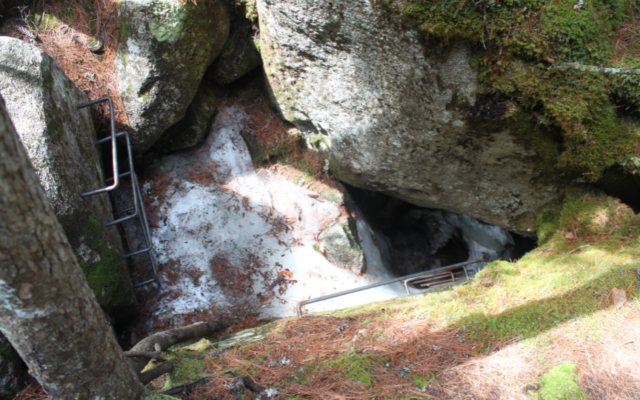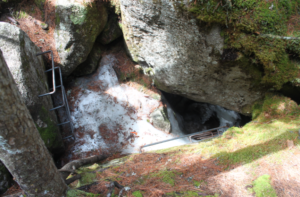
Discover Maine’s geological wonders by searching for EarthCaches
Reversing waterfalls, dormant volcanoes, ancient fossils and many more geological wonders in Maine can be uncovered by searching for EarthCaches. Scattered throughout the state, these outdoor destinations are part of a worldwide hunt that’s accompanied by virtual lessons, written for the everyday person.
EarthCaches are a part of geocaching, which is a popular worldwide activity that involves using GPS coordinates to hide and find caches. The traditional geocache features a container, which contains a logbook and tradeable items. EarthCaches, on the other hand, do not feature containers or any other physical item — aside from the landmarks they highlight. Essentially, they’re stops on a virtual tour.
“Often when we travel, we look at the EarthCaches in the area and go find them, whether it’s a hot spring or the top of a mountain or an old mine,” said Eric Hendrickson of Presque Isle. “It’s a unique way to explore.”
An author and retired natural science educator, Hedrickson began creating EarthCaches in Maine several years ago as a way to reach more people as an educator and contribute to geocaching, an activity he enjoys. To date, he’s created well over 100 EarthCaches throughout the state and abroad. They’re all listed on geocaching.com.
On the website and its linked mobile app, people can sign up for a free basic membership to search for caches. The map tool includes a filter that allows you to search for certain types of caches, such as EarthCaches, traditional caches, letterboxes or mystery caches.

Metal rungs lead down into the ice caves in the Debsconeag Lakes Wilderness Area in Piscataquis County on May 12, 2012. The way down is still coated with ice, and inside the caves, icicles hang from the ceiling. Ice will remain in the caves throughout the summer. Bangor Daily News photo Aislinn Sarnacki
Because EarthCaches don’t involve hiding a container or any other physical object, their impact on the environment is minimal, especially if the EarthCache location can be viewed from a road, trail or other spot that already sees foot traffic. For this reason, EarthCaches are permitted in many places that traditional caches aren’t, such as Baxter State Park, Acadia National Park and many other conserved properties.
While EarthCaches focus on geological features, they aren’t just about rocks. EarthCaches often provide information about a location’s history or the animals and plants that live there.
To create his many EarthCaches, Hendrickson referred to information provided online by the Maine Geological Survey. He then sifted through the facts, crafting short lessons for specific locations.
“They’re typically written at an 8th grade level,” he said. “If you don’t write them that way, [geocaching.com] will modify them for you. They don’t want them to be too technical, so if a family goes out, mom or dad could explain to their kids what they’re seeing without getting into too much depth.”
The majority of the EarthCaches Hendrickson created can be driven to by car, though some require hiking or traveling by boat to find.
EarthCaches are usually easier to find than traditional caches because the landmarks they highlight are often large and obvious. In fact, many people find EarthCaches by simply using the map function on the geocaching.com mobile app — rather than using a handheld GPS device, which is needed to find exact coordinates.
Once you visit an EarthCache, you can log the find through the mobile app or website. Some EarthCache creators create a series of questions you can answer to prove you visited the spot. Photographs also serve as good proof, though they aren’t required. But many EarthCaches have no requirements for logging aside from your word that you visited the location.
“It’s basically an honor system,” Hendrickson said.
To get started, here are some outdoor recreation areas where you can find EarthCaches in Maine.
Some geocachers try to log as many cache finds as possible, earning online badges. In addition, physical EarthCache coins are awarded for finding certain EarthCaches or a series of EarthCaches.
Whatever your goal or strategy, be sure to take time at each EarthCache, reading through the lesson and inspecting the special location. That’s what the activity is all about — exploration and hands-on learning. And if you find that you truly enjoy the activity, maybe try creating your own EarthCache, adding to the worldwide hunt.
—
Where to find Maine adventures that feature geological wonders|
Throughout Maine, recreational trails lead to fascinating geological features, from giant boulders to ancient fossils. And many of these landmarks are highlighted by EarthCaches.
EarthCaches are one of several types of geocaches that are searched for in the popular worldwide activity called geocaching. Marked with specific GPS coordinates, an EarthCache is a location that people can visit to experience and learn about different geological features through quick virtual lessons. They’re mapped on geocaching.com and the site’s mobile app.
You can learn more EarthCaches and how to find them here.
Some EarthCaches can be visited without even stepping out of your car, while others require you to hike, bike or paddle a boat in order to reach them. Here are a few recreational areas in Maine that feature EarthCaches, from the state’s most famous park to small preserves and town-owned trails.
Kenduskeag Stream Trail
A waterfront walkway in Bangor, the Kenduskeag Stream Trail features two EarthCaches, one highlighting an estuary while another describes some dramatic cliffs in a gorge. The trail is just under 2 miles and traces the edge of the Penobscot River and Kenduskeag Stream.
Acadia National Park
Maine’s most popular outdoor destination, Acadia National Park, is home to several EarthCaches. For example, there is an EarthCache on the trail leading to the park’s Bar Island, another at the park’s famous Thunder Hole, and another on Schoodic Peninsula, the mainland portion of Acadia.
Quoddy Head State Park
Located on the easternmost peninsula in the United States, Quoddy Head State Park in Lubec contains three EarthCaches that explain dramatic ocean cliffs and the area’s exceptionally high tides. The 541-acre park is home to a historic red-and-white striped lighthouse, cobblestone beaches, bold cliffs and a network of beautiful hiking trails.
Settlement Quarry in Stonington
Settlement Quarry is an old granite quarry in the island town of Stonington that was last active in 1980 and is now part of a preserve owned and maintained by the Island Heritage Trust. On the preserve is a hiking trail that safely explores the old quarry, as well as an EarthCache.
Daggett Rock in Phillips
An EarthCache can be found at Daggett Rock, a giant boulder that’s thought to be Maine’s largest glacial erratic. A 0.3-mile hiking trail leads to this boulder, which is located on a forested hill in the western Maine town of Phillips.
Debsconeag Ice Caves near Millinocket
Two EarthCaches can be found along the 1-mile trail that leads to ice caves in the Debsconeag Lakes Wilderness Area near Millinocket. They highlight an interesting glacial erratic and — of course — the ice caves.
Baxter State Park
Baxter State Park is home to several EarthCaches. One is located on the Traveler Mountain Range, another is on Mount Coe. Three are located on Katahdin, Maine’s tallest mountain, and a couple of additional EarthCaches are located at gorges at the north end of the park.
Camden Hills State Park
Two EarthCaches are in Camden Hills State Park — on Mount Battie and the other on Megunticook Mountain. The caches explain how glaciers shaped the Camden Hills. They also describe the type of rock that makes up the mountain range.
To find more EarthCaches in Maine and beyond, visit geocaching.com and sign up for free to use the map tool. EarthCaches can be created by anyone — though they must be approved by website management — so more are popping up all the time.